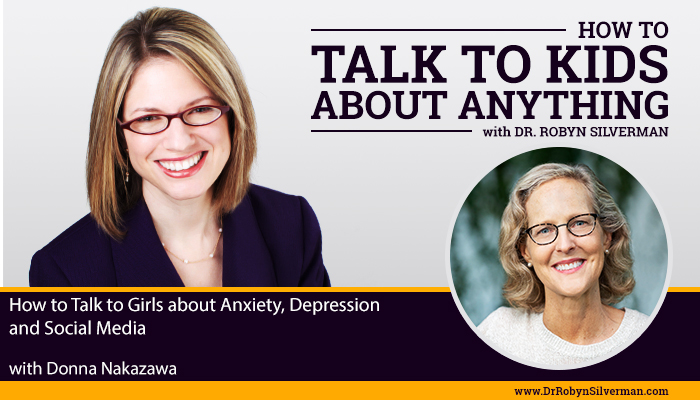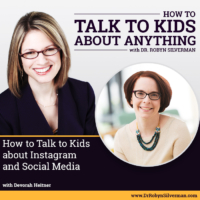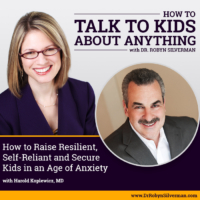Podcast: Play in new window | Download
Subscribe: Apple Podcasts | RSS | More
How to Talk to Girls about Anxiety, Depression, and Social Media

This podcast episode provides an in-depth look at the lives of adolescent girls and their mental health.
Guest Expert: Donna Nakazawa
My next guest tells us that a good litmus test for the health of a any society is how well it treats its girls and how well its girls are faring. Today, some alarming statistics:
- 1 out of 4 adolescent girls reports suffering from symptoms of major depression compared with fewer than 1 in 10 boys
- Girls and young women are twice as likely as boys and young men to suffer from anxiety
- Suicide attempts have recently increased 51% among girls compared with 4% among boys, including girls ages 10 to 14
- Depression occurs more often in girls today than in the past, and it’s presenting earlier than it did just 2 decades ago—often by ages 12 or 13
- Adolescent girls today spend twice as much time on smartphones and on social media than boys
- It’s only since 2016 that scientists began to more deeply consider male and female sex differences in the biological underpinnings for how, when, and why depression and anxiety develop in response to adversity and stress. For decades, lab research used male animals almost exclusively in experiments involving the brain.
Bio
Donna Jackson Nakazawa is the author of four books that explore the intersection of neuroscience, immunology, and emotion, including The Angel and the Assassin, named one of the best books of 2020 by Wired magazine, and Childhood Disrupted, which was a finalist for the Books for a Better Life Award. Her latest book is GIRLS ON THE BRINK: Helping Our Daughters Thrive in an Era of Increased Anxiety, Depression, and Social Media. Her work has appeared in Wired, Stat, The Boston Globe, The Washington Post, Health Affairs, Parenting, AARP Magazine, and Glamour, and has been featured on the cover of Parade and in Time; she has appeared on Today, NPR, NBC News, and ABC News.
Important Messages:
- Toxic stress: Tells the immune system to gear up the body over and over again for whatever might be coming next. The world that we adults have created for our kids is a little more stressful than we would like the world is heating up emotionally, socially, environmentally, politically. It doesn’t matter if you’re looking at climate change school shootings or what’s happening on social media or a pandemic to realize that our kids are being hit from every direction, which with this sense of chronic unpredictable stress.
- Through development across childhood, especially into puberty, the brain is asking one super key question. Am I safe growing up in this world? And knowing that I have to go at it on my own one day pretty soon, or am I not safe? And more and more kids are getting a message that they’re not safe.
- Differences between how the female brain and immune system respond during puberty to toxic stress versus the male brain? Now that neuroscientists are finally looking at a female research model to report on this intersection between stress and girls.
- Inner influences and how puberty can impact our girls and their mental health.
- Stress is affecting the brain and immune system during puberty is that estrogen is a master regulating hormone and not to get too bogged down in the science here, but we think of estrogen as this female hormone. But in fact, it’s a really regulating hormone. It helps the brain hum along and moves smoothly and be flexible. And think big thoughts and, and do 5,000 things in one day as all girls and women know. But at the same time, we tend to think of it as coming in and rushing up hormones that the excitement mood changes. It does so much more than that. It’s actually responsible for remodeling the brain. What happens when it comes rushing in is that the immune system in females, when estrogen onboards gets this big potent extra push.
- Estrogen is the reason why women have a bigger vaccine immune response. More stress hormones cascade through the body. And we know what that means over time, changes in inflammation, in wellbeing, turning on genes that set the stage for both physical and mental health disorders and sculpting the brain in suboptimal ways.
- How can we listen without trying to solve our daughter’s problems? And provide that safe connection and be what we’re supposed to be without problem solving and actually disconnecting. We wanna jump in. We wanna be the detective. We wanna be the fixer. We wanna be the judge, you know, but none of that is helpful. And all the things that are helpful go right out of our brain, because now we’re in fight flight freeze. So this book
- So if our daughter gets to the car and starts like saying, “my friend completely ignored me today.”
- How does that make you feel when your friends behave that way?
- Wow. Can you tell me more about that?
- Oh, that feels really hard. I think anyone in your situation would feel that way. Anyone would feel that way.
- That’s really frustrating.
- Mom, what do you think? Well, you know, I really wanna know what should I do? What do you think? Because we program them right. INSTEAD: “Wow. I really, really will tell you what I think, but first I want to hear what you think, honey, because what you think is so much more important than what I think.”
- We know that high rumination with low action is very much associated with depression and anxiety and allowing kids to see us being safe and regulated and listening gives them the opportunity to feel safe and regulated and listen to. And that in and of itself is an action. Getting girls into a safe place to talk is an action that breaks rumination.
- Strategy: “I don’t think I have all the tools to figure out what’s going on here, but I have a sense that you’re struggling. And I want you to know that even though I don’t have every tool in every minute, I, I care. I love you. I see your light. I want to know. And I’m just going kind of hang around. I’m not gonna hang around in your space, but here’s cup of tea. I’m here. Always this door is always open.”
- “Another good strategy that I’ve found is being able to say, listen, these conversations are hard. Even for adults. They’re hard for everybody. It’s not just you. It can feel like it’s just you, but it’s not just you.
- Promise: “if you come to me with anything that you’re feeling or something hard, I promise not to ask questions,”
- “Do you feel like you need to talk to somebody? Like, do you need to talk to somebody outside of me? Like, would you want a therapist or the counselor to, to talk to? Is there anything that you feel like you’re struggling with?
- Starling effect: Starling: They kick the fledglings out of the nest and put in their own. And we’ve gone from all wanting all kids to rise to kids growing up in an atmosphere where, okay, I know my parents really love Susie, but we both played violin and only one of us is going to get a seat in the youth orchestra. So we, kids are coming of age at a time where being best matters than more even when they really need the message that your big job is just to grow up and be a good person.
- With this individualizing of the family, with this moving away from kind of the village we need outside help. Normalizing. Talk to teachers about it. Talk about how you go to a therapist in front of your children.
- Social media makes things worse.
- It’s important to have that outside help too, because sometimes our, our kids don’t feel like they can talk to us about everything.
- Extrinsic vs intrinsic value and self worth. Dissonance. Be inclusive but be the best! Were your post liked on social media? Mm-Hmm were you invited to the party? Did you get the, a, are you in the honors class? How many colleges wanted you? Did you get this seat in the orchestra? Are you on the, a team or the B team? are you on the travel debate team or the club debate team?
- Parents love when their kids do well. BUT highlight effort. Decenter self. Deprogram self. What does that feel like for you again, “allow their experience to come before yours.”
- You’re creating a sense of emotional safety and connection. What we call the fancy term, “bio synchrony” with your child which is every cell in you is attuned to allowing every cell in her to be her not you.
- We know that the most important thing in girls’ adolescent development, if you were to ask me, what’s the one most important thing to remember is that girls thrive best when they, when their family answers, “Yes,” to this question, can this child come and talk to you about really hard things? So all that we’re talking about is really setting the stage so that we can answer yes.
- “Gender messaging is never a non-issue and you’re discussing safety and sexualization and messaging that goes along those issues.”
- Two big arenas: Online social media and the people who surround her child in her day to day world, right?
- So they’re kind of two different answers in terms of social media. What we’re really looking for is social media literacy. One, it’s having a social media plan in your home. Very few families actually have a conversation, which says, what are our values around social media? How are we as a family? How do we view and value or not value social media in this family? And what does that mean? Well, you know, for us, we value being together at dinnertime. That means no phones at dinnertime. We value sleep. That means cell phones come out of the room. Yeah. For adults too. At, you know, an hour before bedtime, that means that we part two sit down and we talk about what are we seeing? Who made that? What do you think that person felt like when they, when they posted that picture? Well, what do you think? It means that all these comments, this girl is getting are so critical for women and men. Why do you think it is that on TikTok? The more clothes a girl takes off, the more likes she gets, I wonder what’s going on here. What is going on here behind the scenes who made it, what was it intended for? What do we make of these comments? What do you think that we could do differently when we’re posting online and also having those, those family rituals and routines around social media, it also means for the adults, you’re out shopping with your daughter, put your phone away.
- Maybe she’s get in the dressing room, trying something on and you realize it’s a good time to check six work emails. But when she comes out and she’s 14 and her body is developing, she needs to see this person who’s there for her not work emails.
- So for instance, you know, you have this uncle who’s kind of sexist. You’re watching a basketball game and he goes, oh, that girl shouldn’t be wearing that uniform, man. She’d look a lot better in a, in a cocktail dress. “What did you say?” “Can you repeat that?” And getting people to repeat what they’re saying again, and again, and again and again, and this also comes into very simple responses that we can have, for instance somebody says I to be sexist, but she, I don’t let, I don’t be sexist.
- And we have to model them for our girls. When our girls are 10 or 11 or 13 and extended friends or family have a comments. As one girl told me in the book, her dad used to say, when friends came over and she hit puberty early, developed really quickly, oh my God. You know, Julia’s like turned 16 overnight or go put a bra on and she turned around and said to her dad, if you’re friends have a problem with my not having a bra on, maybe they shouldn’t be your friends.. Allowing our girls to speak back when it comes to boundaries for their bodies and how they’re viewed, let girls walk out of the room in the middle of a discussion with their dad, don’t breed, you know, respect for the male word when it’s not warranted or appropriate
- You really want to give girls agency so that they can speak their mind. And they can also say, this isn’t healthy for me. This conversation isn’t healthy for me. And I really don’t want to prolong it anymore, because what you’re saying is, is not only incorrect, but it’s, it’s causing a problem in my, in my body. It’s a causing a problem in my mind. And, and I need to do what’s both. What’s healthiest for me.
Notable Quotables:
- “Through development across childhood, especially into puberty, the brain is asking one super key question. Am I safe growing up in this world?”
- QUESTION: Mom, what do you think? ANSWER: “Wow. I really, really will tell you what I think, but first I wanna hear what you think, honey, because what you think is so much more important than what I think.”
- “If you aren’t regulated, it’s very hard for your child to be regulated.”
- “Getting girls into a safe place to talk is an action that breaks rumination.”
- “We know that high rumination with low action is very much associated with depression and anxiety and allowing kids to see us being safe and regulated and listening gives them the opportunity to feel safe and regulated and listen to. And that in and of itself is an action. Getting girls into a safe place to talk is an action that breaks rumination.”
- “Don’t ruminate over what you’ve done. Right or wrong. Don’t recall. Don’t go back. Don’t ruminate. We’re moving forward here. I promise you, if you don’t recall, don’t ruminate- that’s is a road to depression and anxiety. And it’s a non-action state. We have to break that with action and I can promise you things begin to change when we begin to change.”
- “If you feel like you can’t go into these situations and be the soothing presence, you want to find out what that’s all about.”
- “How can we listen without trying to solve our daughter’s problems? We wanna jump in. We wanna be the detective. We wanna be the fixer. We wanna be the judge, you know, but none of that is helpful.”
- “Allow their experience to come before yours.”
- “You’re creating a sense of emotional safety and connection. What we call the fancy term, “bio synchrony” with your child which is every cell in you is attuned to allowing every cell in her..to be her, not you.
- “What’s the one most important thing to remember is that girls thrive best is when your daughter can say ‘Yes’ to this question: Can this child come and talk to you about really hard things?”
- “Gender messaging is never a non-issue and you’re discussing safety and sexualization and messaging that goes along those issues.”
- We need to allow our girls to speak back when it comes to boundaries for their bodies and how they’re viewed.”
When a child has a cancer diagnosis, we lose a sense of normalcy, says Dr. Jen Pratt on the How to #TalktoKids about Anything podcast. Listen in here.
Click To Tweet
@Makeawish and @Makeawishintl helps to bring a sense of normalcy back to kids who have a childhood illness, says Dr. Jen Pratt on the How to #TalktoKids about Anything podcast. Listen in here
Click To Tweet
Resources:
The post How to Talk to Girls about Anxiety, Depression, and Social Media with Donna Nakazawa appeared first on drrobynsilverman.com.







